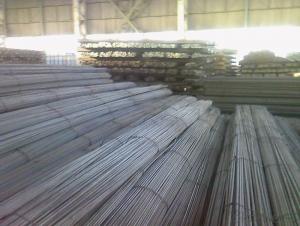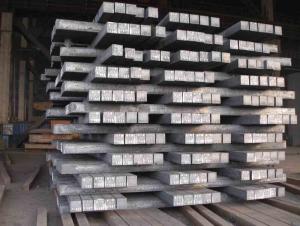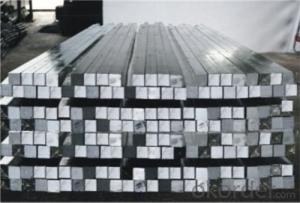Hot Rolled Steel Square Bar with the Size 180mm
- Loading Port:
- Tianjin
- Payment Terms:
- TT OR LC
- Min Order Qty:
- 2000 m.t.
- Supply Capability:
- 20000 m.t./month
OKorder Service Pledge
OKorder Financial Service
You Might Also Like
Hot Rolled Steel Square Bar can be used as steel billet for other steel products like steel angles, channels, I-beams, H-beams, steel Rebar, steel wire rod etc.
Feature:
We have two kinds of Hot Rolled Steel Square Bar which is used as billet, one is produced by blast furnace, the other is produced by electrical arc furnace. The prices are different.

Detail Sizes:
180*180mm
Material Grade:Q235 Q275 3SP 5SP
FAQ:
Packing Detail: The products can be packed naked,loose
The products can be delivered by bulk vessel or by container
Color mark: there will be color marking on both ends of the bundles for the cargo delivered by bulk vessel. That makes is easily to distinguish at the destination port.
Tag mark: the tag marks will be tied up to each bundle. The information is usually including supplier’s logo and name, product name, made in China, products’ specifications and other information requested by customers.
- Q:How do you use a steel square to lay out a dovetail joint?
- In order to lay out a dovetail joint using a steel square, you will require the following tools: a steel square, a pencil or marking knife, and either a dovetail template or a set of dovetail angle guides. Begin by ensuring that your steel square is clean and free from any dirt or debris that may impact your measurements. Then, position the steel square against the edge of the workpiece that will form one side of the dovetail joint. Make sure that the inside edge of the square's blade aligns precisely with the edge of the workpiece. Next, employ a pencil or marking knife to mark the desired width of the dovetail pins or tails on the end grain of the workpiece. The width can be determined based on the size of your stock and personal preference. Generally, a 1:8 or 1:6 angle is utilized for dovetail joints, although this may vary based on the project. Once the width has been marked, utilize the steel square to mark the desired angle of the dovetail joint on the face of the workpiece. Place the blade of the square against the face of the workpiece, aligning it with the mark made for the width of the dovetail, and draw a line along the blade to indicate the angle. Repeat these steps for the other side of the dovetail joint, ensuring accurate and consistent positioning of the steel square. This will guarantee proper alignment and a seamless fit between both sides of the joint. If you possess a dovetail template or angle guides, they can be employed to guide the steel square and simplify the process. Simply position the template or angle guide against the edge of the workpiece and use the steel square to mark the width and angle accordingly. Always remember to double-check your measurements and marks prior to cutting the dovetail joint. Accuracy is of utmost importance for a tight and sturdy joint.
- Q:Can a steel square be used for laying out a patio?
- Yes, a steel square can be used for laying out a patio. A steel square is a versatile tool that can be used to measure right angles and ensure accurate and square corners during the patio layout process. It can help in aligning and positioning the patio pavers or stones, resulting in a well-designed and level patio surface.
- Q:How do you use a steel square to determine angles for wainscoting?
- To use a steel square to determine angles for wainscoting, there are a few steps you can follow: 1. Measure the height and width of the area where the wainscoting will be installed. This will help you determine the size and dimensions of the wainscoting panels. 2. Place the steel square against the wall, ensuring it is flush and level. The long edge of the square should be against the wall, while the shorter edge is facing outward. 3. Align one leg of the square with the bottom edge of the wall or baseboard. Keep the other leg of the square perpendicular to the wall. 4. Trace a line along the longer edge of the square using a pencil or marker. This line will serve as a reference for cutting or installing the wainscoting panels. 5. Next, measure the height of the wainscoting panels and mark it on the wall using a tape measure. This will help you determine where the top edge of the wainscoting should be. 6. Align the square with the top edge of the wainscoting mark and trace another line along the longer edge of the square. 7. By connecting the two lines you have traced, you should now have a reference angle for the wainscoting. This angle will help you determine how to cut the top and bottom edges of the wainscoting panels to fit the wall properly. 8. Repeat this process for each section of the wall where wainscoting will be installed, ensuring that the square is properly aligned and level each time. Using a steel square in this way can help you achieve precise and accurate angles for your wainscoting, ensuring a professional and visually appealing installation.
- Q:What is the difference between a framing square and a steel square?
- A framing square is a woodworking tool primarily used for laying out and measuring right angles, while a steel square is a metalworking tool used for marking and measuring angles in metal fabrication.
- Q:Can a steel square be used for measuring the thickness of sheet metal?
- No, a steel square cannot be used for measuring the thickness of sheet metal as it is primarily used for checking right angles and measuring lengths or angles, not for measuring thickness.
- Q:Can a steel square be used for checking the squareness of window openings?
- Window openings can have their squareness checked using a steel square. This tool, also referred to as a framing square or carpenter's square, is highly versatile in carpentry and construction. It serves various purposes, including the examination of object squareness. When applied to window openings, the steel square guarantees that the corners of the window frame align perfectly at 90-degree angles. By positioning the steel square against the window opening's corners, one can effortlessly determine if adjustments are needed. The precise right angles and straight edges of the steel square establish it as a dependable tool for assessing window opening squareness and ensuring accurate installation.
- Q:How do you use a steel square to determine roof pitch?
- To determine the roof pitch using a steel square, you can place one leg of the square on the roof surface and align the other leg with the horizontal run or rise of the roof. By reading the measurements on the square, you can easily determine the angle or pitch of the roof.
- Q:Can a steel square be used for surveying work?
- Yes, a steel square can be used for certain surveying work, such as measuring right angles and checking the alignment of objects. However, it is not typically used as a primary tool for more precise surveying tasks, which usually require more specialized instruments such as total stations or GPS receivers.
- Q:How do you use a steel square to determine the slope of a roof valley?
- To use a steel square to determine the slope of a roof valley, you would first place one leg of the square on the roof surface and the other leg on the valley. Then, adjust the square until it is level. By reading the angle indicated on the square, you can determine the slope of the roof valley.
1. Manufacturer Overview |
|
|---|---|
| Location | |
| Year Established | |
| Annual Output Value | |
| Main Markets | |
| Company Certifications | |
2. Manufacturer Certificates |
|
|---|---|
| a) Certification Name | |
| Range | |
| Reference | |
| Validity Period | |
3. Manufacturer Capability |
|
|---|---|
| a)Trade Capacity | |
| Nearest Port | |
| Export Percentage | |
| No.of Employees in Trade Department | |
| Language Spoken: | |
| b)Factory Information | |
| Factory Size: | |
| No. of Production Lines | |
| Contract Manufacturing | |
| Product Price Range | |
Send your message to us
Hot Rolled Steel Square Bar with the Size 180mm
- Loading Port:
- Tianjin
- Payment Terms:
- TT OR LC
- Min Order Qty:
- 2000 m.t.
- Supply Capability:
- 20000 m.t./month
OKorder Service Pledge
OKorder Financial Service
Similar products
New products
Hot products
Related keywords



























